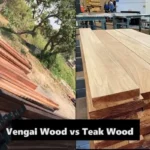Solid wood has a traditional history passed down through generations that epitomizes the strength, longevity. Advancements in woodworking and innovations in scientific research led to the growth of Plywood as an eco-friendly and sustainable alternative. Comparison of Solid wood and Ply wood should be done by analyzing various factors such as durability, flexibility, strength, cost, availability.
Solid wood:
Solid wood is a natural wood obtained from trees. The timber logs from the trees are cut into smaller pieces as desired in the saw mill. These sawn logs can be used directly or can be kiln dried. Kiln drying reduces the moisture and increases the strength and dimensional stability of the timber.
Pros:
– Strength and Durability:
The homogeneous Solid wood available from wide varieties of Teak wood, oak, Rose wood, Cherry, Maple, Mahogany trees definitely are considered to be stronger, sturdier, heavier and denser. It can withstand significant wear and tear. Solid wood is ideal and elegant in making high quality furniture and cabinets.
– Maintenance:
Solid wood get darken over years, it should be properly sanded and re-polished in regular intervals. This brings fresh life to wooden works and thereby it regains its color and shine. The proper maintenance of Solid wood results in long life and can help to last it over generations.
– Appearance:
Solid wood stands top in the stack in terms of aesthetics. The warmth given by the teak wood with its solid wood grain structure in golden brown color gives a feel- good appearance which can’t be offered by any of the woods.The structural appearance of the each wood will be unique resulting the outcome be distinctive.
Cons:
– Cost:
Due to deforestation, Solid Wood was rarely available causing a hike in demand. Higher demand and low supply leads the Solid Wood to be quite expensive. As a result, it can’t be afforded by everyone. The factors such as Ecological advantages, durability, and longer time to get matured also aids the raise in the cost of wood.
– Environmental impact:
The seasonal changes have an effect in wood causing shrinkage and expansion based on humidity. Regular maintenance is needed or else the environmental changes lead to crack or spilt or wrap over years.
– Wastage:
While processing solid wood blocks, for effective utilization minimum of four pieces should be split from its sides. This result in significant amount of wood is being discarded as waste.

Plywood:
Plywood is a type of engineered wood created by sticking multiple layers of veneer in different directions. The veneers are from logs of wood, which are peeled into thin sheets. Depending on quality and thickness of the veneer, grades can be varied. Many grades of hardwood and softwood plywood are available in the market.
Pros:
– Dimensionally stable:
To enhance the dimensional stability and strength each layer of ply is oriented at 90 degree to its adjacent layer. This design gives plywood equal strength in both directions, which sets it apart from solid wood. On other hand, plywood keeps the same level of moisture throughout its structure. This makes it a reliable and flexible material to work with.
– Durability:
As Plywood is moisture resistant and termite resistant, the furniture materials are less susceptible to swelling or shrinking. Despite of wide range of prices and options available it steps ahead in low maintenance and durability. For making furniture Plywood is more durable and reliable.
– Affordability:
A nicely-laminated plywood surface is low-preservation because of its scratch and moisture resistance, easily wiped clean with a humid material to cast off any stains. Solid wood’s shortage drives up its value, making plywood a more low-priced alternative. Opting for plywood now not only saves money but also promotes a healthier and green choice.
Cons:
– Limited applications:
Plywood has its limits in robustness. As it is not as tough as solid wood it is not preferred to the places where to handle heavy weights without any additional support. Plywood cannot support prolonged exposure to moisture in such as cases it need extra protective measures.
– Aesthetics:
Plywood is not aesthetic. It requires additional effort, labor, and cost to elevate its beauty. Despite of its reliability, plywood fails to replicate the aesthetic look as solid wood does. It may not be a best choice where the natural beauty is a factor.
– Chemical adhesives:
Formaldehyde is one of the substances used as glue in plywood. Three layers plywood has two layers of glue; strong plywood with 13 or 15 layers has more layers of adhesives resulting in air pollution. So it is not preferred for indoor applications.


